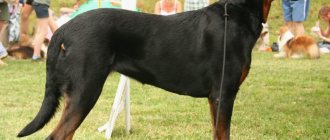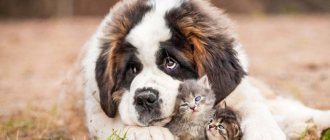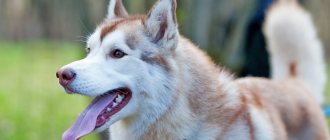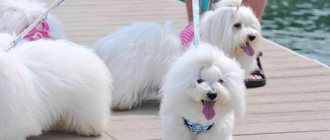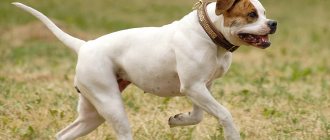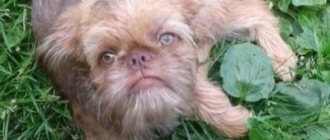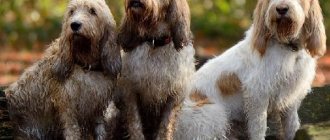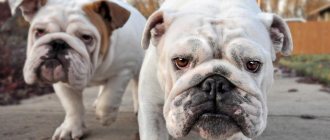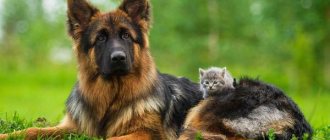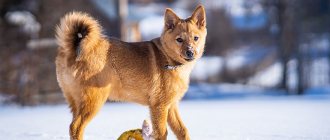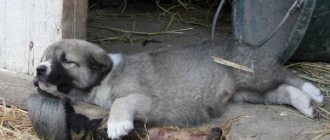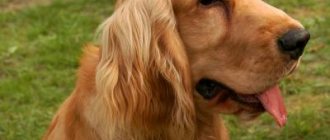Doberman: history of the breed
These animals were bred in Germany thanks to the dedicated work of a German civil servant named Friedrich Louis Dobermann. The duties of this person included collecting taxes. Therefore, he needed a reliable protector in the form of a formidable dog.
To create a new type of pinschers, several dog breeds were used at once. It is known for certain that the blood of Greyhounds, Rottweilers and Great Danes flows in the veins of the modern Doberman. It is possible that terriers, German pinschers and even mixed breeds with a suitable exterior took part in the formation of the new breed.
In 1899, the first club of Dobermann lovers was created. Around the same time, an official breed standard was developed. In 1960, these dogs received recognition from the World Cynological Federation.
German
The German Pinscher is a breed-forming direction for the creation of such common breeds as the Dobermann or Schnauzer. This ancient species was recognized back in 1879.
Currently widespread in Europe, and especially in their homeland, Germany and France. This medium-sized dog has an elusive elegance in its appearance.
Important! The German Pinscher is a getter - anything he considers can be his prey. It should not be kept in a house where there are small children.
The strong-willed character of the dog requires firmness from the owner, who will be able to curb the pet’s willfulness. Despite excellent watchdog abilities and extreme suspicion of strangers, the German Pinscher treats his owner’s family members very well.
The dog does not make unnecessary noise unless necessary, but begins to bark when there is a real threat. This dog can transform its energy into destructiveness and simply engage in sabotage - tearing up children's toys or damaging furniture.
Description of the breed:
- Country: Germany.
- Height: for females and males from 45 to 50 cm.
- Weight: from 14 to 20 kg.
- Color: red, brown, gray, black, fawn, with shades of blue.
- Price: from 1000 to 3000 US dollars.
Doberman: description of the breed
These are athletic, harmoniously built, high-legged dogs with strong, moderately wide bones. Depending on the gender, the height of an adult animal is 63-72 cm, and the weight can reach 32-45 kilograms. On the wedge-shaped head with a wide forehead, smoothly turning into the bridge of the nose, there are developed cheekbones and oval eyes, the color of which matches the color of the coat. The pinscher's cropped ears are shaped like an isosceles triangle with a pointed apex.
The dog's long, muscular neck smoothly transitions into a prominent ash, a short and wide back, and a slightly raised, rounded croup, ending at the base of a high-set, cropped tail.
The entire body of the animal is covered with hard, tight-fitting guard hair, under which there is generally no undercoat. The color of this breed can be black or brown with red-orange tan.
Peculiarities
The Doberman Pinscher is a dog completely unsuited to life in an enclosure. Since she has no undercoat, she only needs to be kept indoors, because in winter she will simply freeze. Caring for any representative of this breed comes down to regular examination of the teeth, claws, ears and eyes. Once a week, the animal should be cleaned with a special glove or a soft brush. It is advisable to bathe your dog using a special shampoo. Moreover, it is recommended to do this no more than twice a year.
Dobermans are not prone to allergies. Therefore, you can feed them with both natural and industrial food. In the first case, a couple of times a year you need to additionally give your pet a vitamin and mineral complex that contains seaweed.
It is necessary to walk such a dog regularly and for a long time so that it can splash out the accumulated energy. In winter, before going outside, it is recommended that your dog wear insulated overalls.
How to choose a puppy
It is best to take a small puppy into your home. He will get used to the new owner faster, and you can train him to suit you. This will not work with an adult dog, because you already get a creature with a formed character.
It has been said many times that a puppy should only be adopted from a kennel. A miniature pinscher bought at a poultry market can turn out in six months to be a huge outbred mongrel, only vaguely reminiscent of a miniature pinscher.
There are several puppies in a pinscher litter. It is worth examining them carefully, because even at one month of age they have different characters. You should not choose a noisy baby who barks at everyone, just as you should not choose one that is too shy. You can ask the breeder to give the babies their usual food in your presence. It is well known that pinschers have a good appetite. A child who is not eager to reach the plate should definitely raise suspicion.
It is also important to observe the behavior of the bitch. If she is nervous and aggressive, some of these unpleasant qualities can be passed on to the kids.
Once you have made your choice, be sure to examine the appearance of your future pet. The puppy should have shiny fur, its ears and eyes should be clean, and its limbs should be straight.
The color of a pet can change, the character can also be nurtured, but crooked legs are unlikely to be straightened out.
If everything suits you, and the baby, in addition to everything else, also shows increased interest and sympathy for you, do not hesitate and take home a soft bundle of happiness.
German Pinscher: origin of the breed
The history of these animals began in the 16th-17th centuries. They were bred in Germany from swamp dogs that hunted small rodents. The first representatives of this type of pinschers were called rutters. They were kept on farms and used as guards and rat catchers.
After some time, these animals were brought to the USA and Switzerland. It was from this moment that targeted work began to improve the German Pinscher. A little later, these dogs took part in the formation of Rottweilers, Dobermans and several other breeds.
German Pinscher: description
These are proportional, compact animals with a light build and dry constitution. The height of an adult varies between 43-58, and the weight can reach 12-16 kilograms. On an elongated, narrow-muzzled head with a weakly defined stop, there are dark, shiny eyes and high-set, hanging or cropped ears.
The short neck of the German Pinscher smoothly transitions into prominent withers, a strong, flat back and a short, slightly lowered croup, ending with the base of a saber-shaped tail. Under the well-muscled body there are two pairs of straight, thin-boned limbs.
The entire body of representatives of this type of pinschers is covered with straight, hard, shiny, tight-lying guard hair with practically undeveloped undercoat. The color of these dogs can be marbled, one- or two-color. In the latter case, on the main black background there are symmetrical, clearly defined red or mahogany tan marks. As for single-colored individuals, their shade is often compared to the color of a reddish deer or chamois.
Content Features
German Pinschers are dogs suitable for living in urban environments. They are very clean and do not require specific coat care. In order for the dog to have an attractive appearance, it needs to be treated with a soft brush a couple of times a week. It is advisable to bathe such an animal when it gets dirty, using the appropriate shampoo.
In addition, you should not forget about your pet's eyes and ears. They need to be regularly inspected and cleaned of accumulated dust and dirt. The pinscher's claws require no less attention. They are systematically trimmed with a special device.
Since representatives of this breed are endowed with an active temperament, they need to be walked regularly. To prevent the dog from freezing in the winter cold, it is dressed in insulated clothing before leaving the house.
Miniature Pinscher puppies
In order for your pet to grow into a beautiful, intelligent miniature pinscher, you need to devote enough time to raising it. If you do not have dog training skills, contact a trainer. He will tell you the main character traits of miniature pinschers and how to interact with them.
The puppy's diet should be rich in calories and calcium. Before bringing your pet home, talk to the breeder. What the puppy was fed before should be his diet for at least another week. This way you will simultaneously alleviate the stress of moving to a new home and eliminate rejection of the new menu.
If you decide to feed your baby dry food, choose a special one for small breed puppies. The food must meet all standards and be at least premium. This is the only way to achieve a harmonious diet for your dog.
Bad food will not only clog the stomach, but will also not provide the animal with all the necessary substances and microelements, which are the basis for future health. A lack of calcium will affect the development of the musculoskeletal system, and a lack of protein will affect the general condition of the growing body.
Until 4 months of age, dry food should be soaked in a small amount of water. Be sure to place a bowl of clean drinking water nearby and refresh it daily.
A puppy from 2 to 6 months needs four feedings a day, after 6 and up to 9 months - three times a day, and after 9 months of age, a miniature pinscher can switch to an adult diet twice a day (morning and evening).
Austrian Pinscher: history of the breed
This breed dates back to the 18th century. Images of similar dogs were found in paintings dating back to 1700. The exact origin of these animals still remains unknown. According to one version, they appeared as a result of crossing German pinschers with local dogs. It is possible that some varieties of terriers took part in the formation of the breed.
The Austrian Pinscher is a dog used for all kinds of farm work. He successfully coped with protecting the owner's property, exterminating rats and driving cattle. After people no longer needed the help of these animals, they became endangered. The breed was saved only thanks to the efforts of enthusiasts.
How to buy a puppy
It is advisable to purchase a pinscher puppy from nurseries, where they will provide all the necessary documents for it and inform the future owner about the specifics of feeding and vaccinations.
The puppy must be active, inquisitive, and friendly. Excessive aggression, cowardice, and lethargy are not acceptable. But the most important thing, of course, is health. The future family member should have shiny, glossy fur, clear eyes, straight strong legs, and a moderately well-fed tummy.
The cost of German and miniature pinscher puppies is 20,000-25,000 rubles. However, if buying miniature pinschers due to their popularity does not present any difficulty, then German ones are rare for Russia. Dobermans are a little more expensive - from 25,000 to 40,000 rubles. The price for Austrian Pinscher puppies is even higher, on average - from 40,000 rubles. The most expensive are Affenpinschers. A puppy from a kennel will cost the future owner 70,000-100,000 rubles.
Austrian Pinscher: description
These are stocky, not too large animals with a wide, barrel-shaped chest and a powerful neck. Depending on the sex, the height of an adult is 42-50 cm, and the weight varies between 12-18 kg. The pear-shaped head with a short muzzle and well-defined stop has large dark eyes and triangular drooping or erect ears.
The dog's powerful neck smoothly transitions into prominent withers, a short back and an even croup, ending with the base of a high tail curled into a ring. The entire body of the animal is covered with straight, smooth hair of red, brownish-yellow, fawn or black with white or reddish markings.
Content Features
Representatives of this breed adapt well to any conditions. They are quite clean and can live in city apartments. Pinscher puppies are very smart and quickly learn to fulfill their natural needs outside.
In general, caring for these dogs comes down to regular washing, combing, trimming nails, and cleaning teeth and ears. In addition, you need to make sure that the dog receives a nutritious, balanced diet and intense physical activity. The inability to release accumulated energy will cause a number of behavioral problems to arise. A dog that is not walked enough turns into a nervous, aggressive and irritable creature prone to destruction.
Lifespan
Mini-Peis, like standard representatives of the breed, live on average 10-12 years.
In pets with good heredity, life expectancy can reach up to 14 years, but if there is a hereditary tendency to diseases, then the indicator drops to 9 years.
Miniature representatives of the breed, like their older brothers, have good immunity, but they still have a tendency to certain diseases, among which the following are distinguished::
- various types of allergies;
- entropy (turning up of eyelids);
- skin diseases;
- malfunction of the thyroid gland;
- ear infections.
To prevent diseases, it is important to undergo routine examinations with a veterinarian and organize the correct diet and physical activity for your pet.
Miniature Pinscher: history of the breed
Germany is considered the homeland of these tiny dogs. Scientists have still not been able to establish the exact date of origin of this breed. What is known for certain is that the first mentions of dogs that look like mini-pinschers date back to the 15th century.
In those ancient times, they lived near the stables and regularly destroyed rats. Later, these dogs began to be taken with them on hunts and on various trips, so that they would scare away possible enemies with their ringing bark. Now representatives of this breed are kept exclusively as pets.
Personality of mini-pei
The Mini Pei is a full-fledged representative of the breed with all the characteristic characteristics, the only difference is the pet’s growth.
A distinctive feature of the character is pronounced leadership qualities . Mini Shar-Peis cannot be called flexible and obedient babies; they require a firm hand from their owner. experienced in raising and training dogs.
Despite the serious expression on their faces, minis are quite cheerful and playful.
They are loyal to their owner, but can be disobedient towards children or elderly people in the family . Mini-pei have peculiar relationships with other animals; they are sometimes cocky towards other dogs and cats.
The Mini Shar Pei has retained the protective qualities of the breed; it is wary of strangers and will protect the property of its owner and himself to the last.
With proper upbringing , a mini-pei will not cause problems; it can become a caring friend, a guard, and show calm and balance .
Expert opinion
Kozhevin Semyon Kirillovich
Expert dog handler.
“The Shar Pei breed is loved by many; they are ancient representatives of man’s four-legged friends, who captivated us with their extraordinary appearance and strong character. Of course, having a small living space, it is difficult to keep a large or even medium-sized dog. More and more buyers want to get a mini version of their desired breed. Shar Peis are no exception. Mini Shar Peis are similar to their older brothers in everything, the only difference is in height. But before the age of one year, there is a high probability that the dwarf Shar Pei will grow almost to the standard. It is impossible to be 100% sure that a three-month-old mini puppy will not later turn out to be of normal size.”
Miniature Pinscher: description
These tiny animals are a smaller version of the Doberman Pinscher. Unlike its larger brother, an adult mini pinscher grows up to 25-30 cm, and its weight does not exceed 6 kg. On a small, proportional head with a noticeable transition from the forehead to the muzzle, there are oval dark eyes and cropped, high-set ears.
Under the slender, well-muscled body with strong bones and a thick neck there are two pairs of long, smooth limbs. The tail of such a dog is usually docked almost immediately after birth.
The entire miniature body of the miniature pinscher, the price of which depends on several important factors, is covered with smooth, shiny hair. As for color, it can be brown-red or black and tan. In the latter case, the marks must be located in strictly regulated places.
miniature pinscher
Miniature pinschers appeared at the beginning of the twentieth century. In 1925 alone, about 1,300 entries were made in the stud book. In appearance, it is a smaller copy of the German Pinscher.
Appearance of the miniature pinscher:
- Height at withers: from 25 to 30 cm.
- Weight: from 4 to 6 kg.
- Color: black and tan or solid, like the German Pinscher.
- The front and hind legs are straight and strong, but the hind legs are slightly longer than the front legs.
- The eyes are dark, with pigmented eyelids.
- The nose line is straight, without a hump.
The character of miniature pinschers is balanced, lively and compliant.
They are good for families and get along with children and cats.
Content Features
This miniature breed is ideal for living in urban environments. This dog takes up very little space and practically does not shed. Another significant advantage of tiny animals is their unpretentiousness and cleanliness.
A miniature pinscher, the price of which ranges from 10-30 thousand rubles, does not need frequent washing or regular combing. You need to bathe such a dog as rarely as possible, since there is a high risk of catching a cold. You should also systematically trim your pet’s claws, because they do not have time to wear down naturally.
During walks, it is better not to let such a baby off the leash so that he is not accidentally injured by passers-by or other dogs. In winter, before leaving the house, the animal must be dressed in insulated overalls.
Care and maintenance of the miniature pinscher
The Miniature Pinscher is a small short-haired dog with the habits of an adult guard breed. First of all, you need to provide her with sufficient space to play, allocate a place to sleep and take an active part in socialization.
The Pinscher's coat does not require special care, but it does not protect him from frost. In winter, your pet will need a warm jumpsuit. Clothing for dogs is sold in specialized stores, or you can sew it yourself. In severe frosts, you will also need boots, because your pet's paws freeze quickly.
In hot weather, do not leave your dog in direct sunlight to avoid heat stroke. If you need to spend a lot of time in the sun, try to wet your Pinscher's coat with cold water.
Without long walks and games, a miniature pinscher can become fat. Even litter box trained pets need active play. If you leave your pet alone for a long time, he can find something to do on his own, adapting your things for his toys.
You don't need to bathe miniature pinschers too often. After bathing, there is a high risk of your pet catching a cold.
The small weight of the Pinscher does not allow the claws to wear down during a walk. From time to time you need to shorten them with special tweezers.
Affenpinscher: history of origin, description and care recommendations
This is one of the oldest European breeds, the first mention of which dates back to the beginning of the 16th century. The official homeland of the Affenpinscher is the German port town of Lubeck, formerly part of the Hanseatic League. They were originally bred to kill rodents. According to experts, Brussels griffins, certain varieties of terriers and even Asian pugs took part in the formation of the breed. Be that as it may, today these interesting creatures enjoy the well-deserved love of world breeders and ordinary owners. In many cities there are nurseries for pinschers with the original monkey face.
These are small compact animals, whose height is 20-28 cm, and their weight ranges from 3.5-6 kg. On the dome-shaped head with a convex forehead and pronounced stop, there are huge round eyes and high-set ears. Under the square, muscular body with a straight topline and a developed, slightly flattened chest, there are two pairs of smooth, strong limbs. The entire body of the Affenpinscher is covered with coarse black hair. The animal's face must have sideburns, a beard and bushy eyebrows.
The Affenpinscher is an unpretentious dog that easily adapts to any living conditions. The only inconvenience associated with caring for this animal may be the need for regular trimming. Also, the owners of such a dog should be prepared for the fact that they will have to systematically trim the hair around their pet’s eyes. Otherwise, the dog will begin to lose vision.
Despite its miniature size, the Affenpinscher is very energetic. Therefore, he should have the opportunity to splash out the accumulated energy on walks in city parks. At the same time, it is recommended to protect him from contact with larger brothers so that they do not accidentally injure him.
If, after reading the above material, you decide to purchase such a puppy, we recommend that you contact a specialized nursery or a professional breeder. Because this is the only way you will be completely sure that you are paying a lot of money for a purebred puppy with all the relevant documents, and not buying a pinscher cross, from which anything can grow.
Education and training
The Miniature Pinscher is known for having a constant desire to assert its own leadership. In this case, only early education is indicated, since without it the dog will develop aggression, which over time will develop into anger. The recommended age for starting classes is 3-4 months. This is exactly the moment when the animal’s nervous system is already formed and it is able to understand the owner’s requirements and fulfill them.
The greatest results will come from consistency and firmness in education.
You should not abuse punishment, remembering that the miniature pinscher is a proud and very touchy creature. Only kindness can make an animal truly love you.
You definitely need to scold your pet if he does something forbidden. For example, do not allow anyone to bite your arm or leg under any circumstances. Perhaps now it is ticklish or simply unpleasant, but in the future the miniature pinscher will bite you not like a child, because the baby teeth will be replaced by sharp fangs.
Pity is also unacceptable when raising this dog.
A smart puppy will quickly see through the owner and will certainly begin to manipulate him.
In general, the miniature pinscher is quite trainable. With the necessary effort, you will notice positive results in the near future. A little playful and hyperactive pet will become a balanced companion.
The dog will show increased activity for the rest of its life.
Only isolated cases provide an example of how a miniature pinscher became calmer with age.
